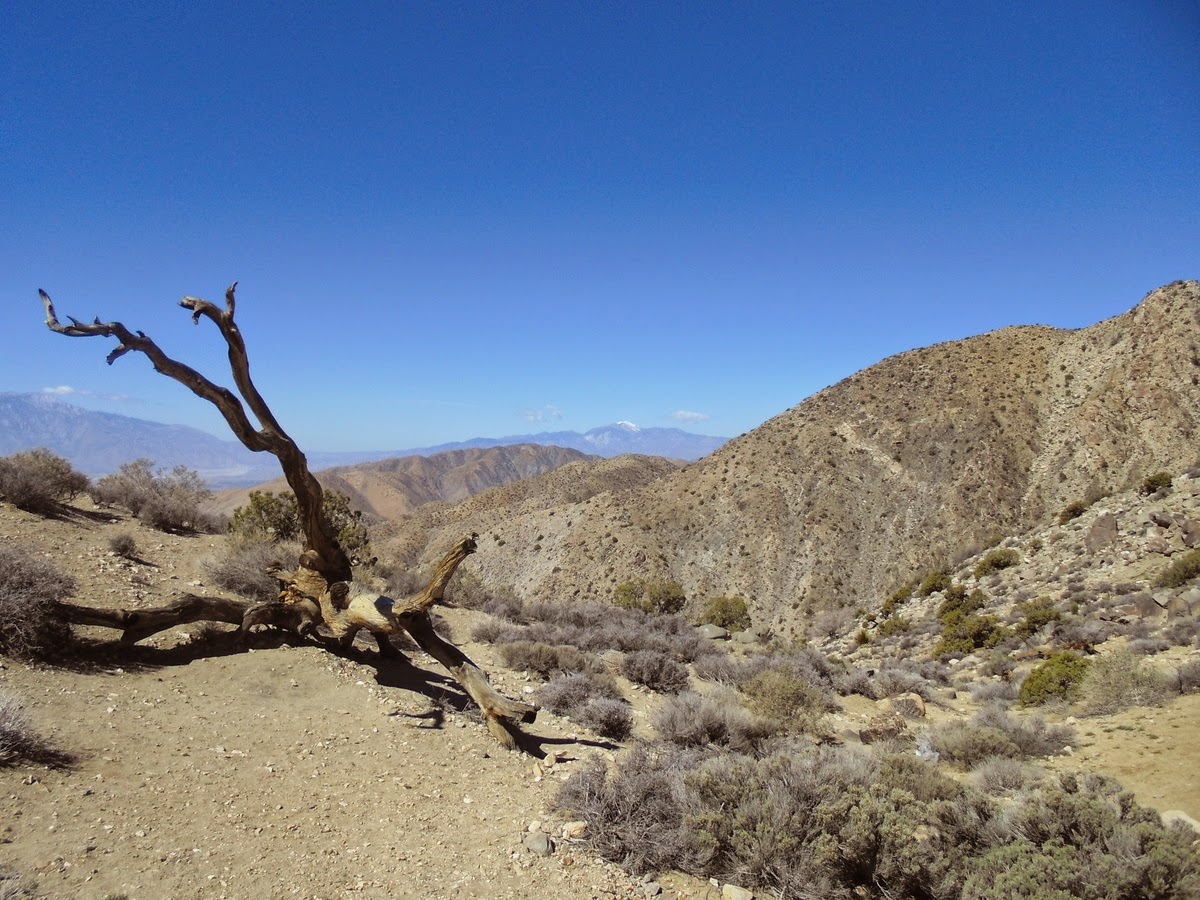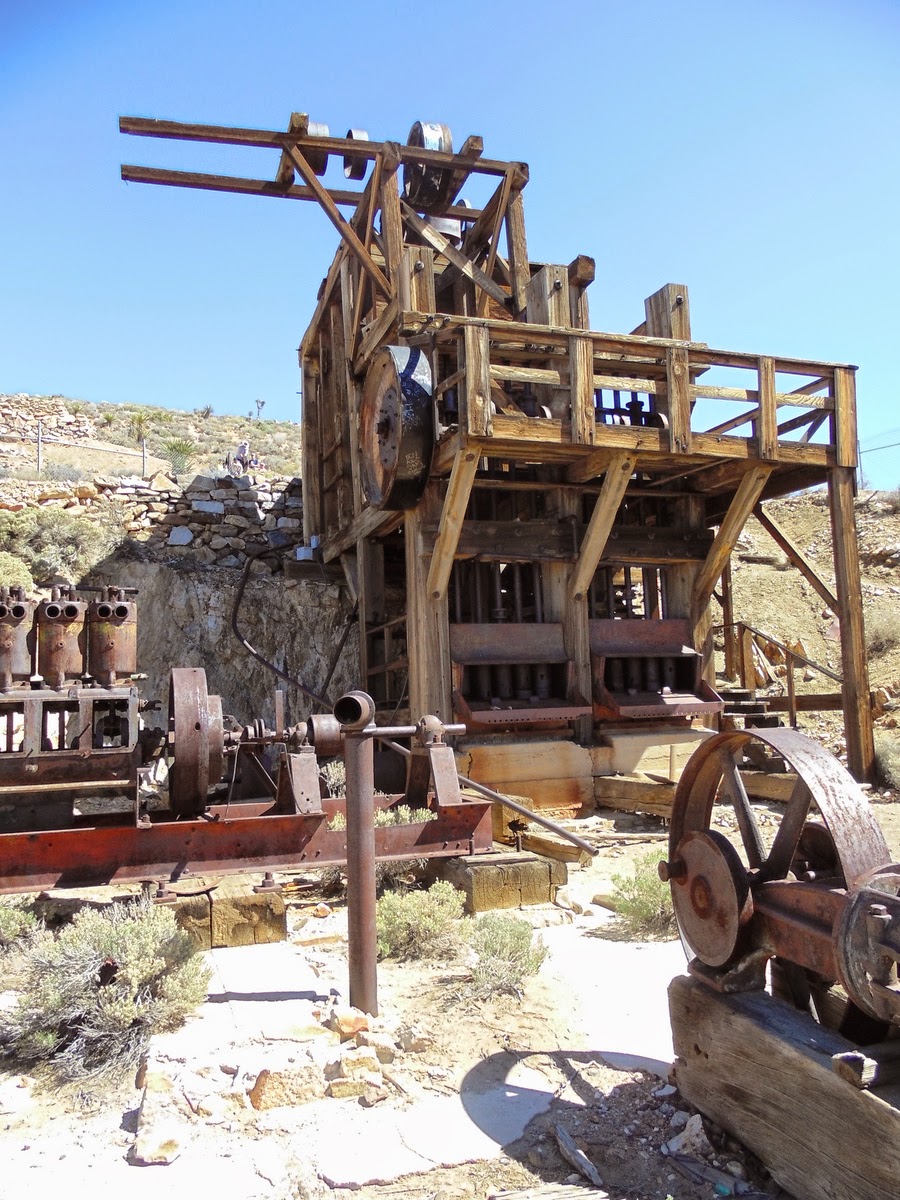We decided early in the day that we
would stay another night at Jumbo Rock campground. It was well enough
situated for any other hike we chose to do, the tent was set up, and
we could leave part of our stuff at the campsite.
At the visitor centre we had found out
that there was going to be a ranger talk at Barker Dam on Thursday
morning. We attended this 1 1/2 hour interpretive hike, and also the
one on Friday morning that started at Skull Rock. Both were highly
interesting and very worthwhile, as we have found ranger talks to be
in general, but I won't dwell on them now and instead move on to our
hike on Thursday afternoon.
Again on the recommendation of the
first ranger at the visitor centre we chose the six-mile hike that
would lead us to Lost Horse Mine and then loop back to the parking
lot. The loop was one option; the other, chosen by most visitors,
would have been to return the way we came, which sounded less
enticing.
This time the sun was blazing down and
the sky a deep blue, the promise of the starry night fulfilled. The
hike to the mine – named, supposedly, after miner Johnny Lang's
search for a lost horse that led him here – led through an area
where a fire had gone through. Blackened tree trunks and chollas,
hillsides even barer of brush than we had seen before seemed a bit
dreary at first sight. Yet the soil seemed more fertile, almost moist
at times, and everywhere we looked it had started to green up. Yucca,
grass, phacelia, desert paintbrush,
tiny purplish flowers, small tufts of herbaceous
plants – this was well on its way to recovery, even if it would be
a long, long time until the trees and shrubs were growing again.
Birds were singing from outcrops of rock along the way, and like
everywhere else lizards darted across our path.
The mill itself is surrounded by a
page-wire fence because of poisonous materials still present in the
soil, but also to conserve the site. From 1893 to 1936 gold was mined
here with the help of a ten-stamp mill, 9000 ounces of it. The
different parts of the machinery are still well recognizable, and a
ten-stamp mill must have been a very effective and progressive way of
mining.
 |
| One of many abandoned attempts |
All over these hills is evidence of
mining, by far not all practiced at such a great scale. Here, too, I
tried to imagine what it might have been like for those solitary men
to come here into this waterless wilderness, to start digging again
and again, every time full of hope that this time it was going to be
the big find. How many times did they go through all that hard work
in vain? How many disappointments, how much loneliness, how much
hardship? All for the desire to strike it rich. Or was it, after a
while, just something that they couldn't escape anymore? An urge to
keep digging, sometimes against all odds, just because they had been
there so long that they couldn't imagine not to do any longer?
But
all this, of course, is idle speculation, triggered, maybe, by things
like this iron bedstead, these rusted pails, the oven made from
carefully piled rocks we came upon on our way down from the mine?
I loved this part of the hike, the
narrow trail winding along the side of the slope, without any
evidence of fire, the plain stretching below, strange rock formations
and a black cone – one of the volcanoes the ranger had mentioned,
perhaps? - rising like warts from its expanse. After some up and down
we descended to the bottom of the valley and walked in loose, gritty
sand again, through a plain with a forest of the trees after which
the park has been named. Joshua trees in all sizes grew here, some
old and with many branches, others just a single 'sapling' rising
from the ground.
 |
It felt strange to walk through this
prehistoric landscape where dinosaurs would not have felt out of place. I would have easily switched the bigger part of that part
of the trail for the middle part that led us through the rugged
beauty of the rocky hills.
Joshua Tree National Park was a wonderful experience, and there would be many more hiking trails to explore. Maybe another year ...
Tomorrow we will move on to Death Valley National Park and pitch our tents there for a couple of nights if we can find a camp spot. Will it really be as desolate as it sounds?
I guess we'll soon find out.













No comments:
Post a Comment